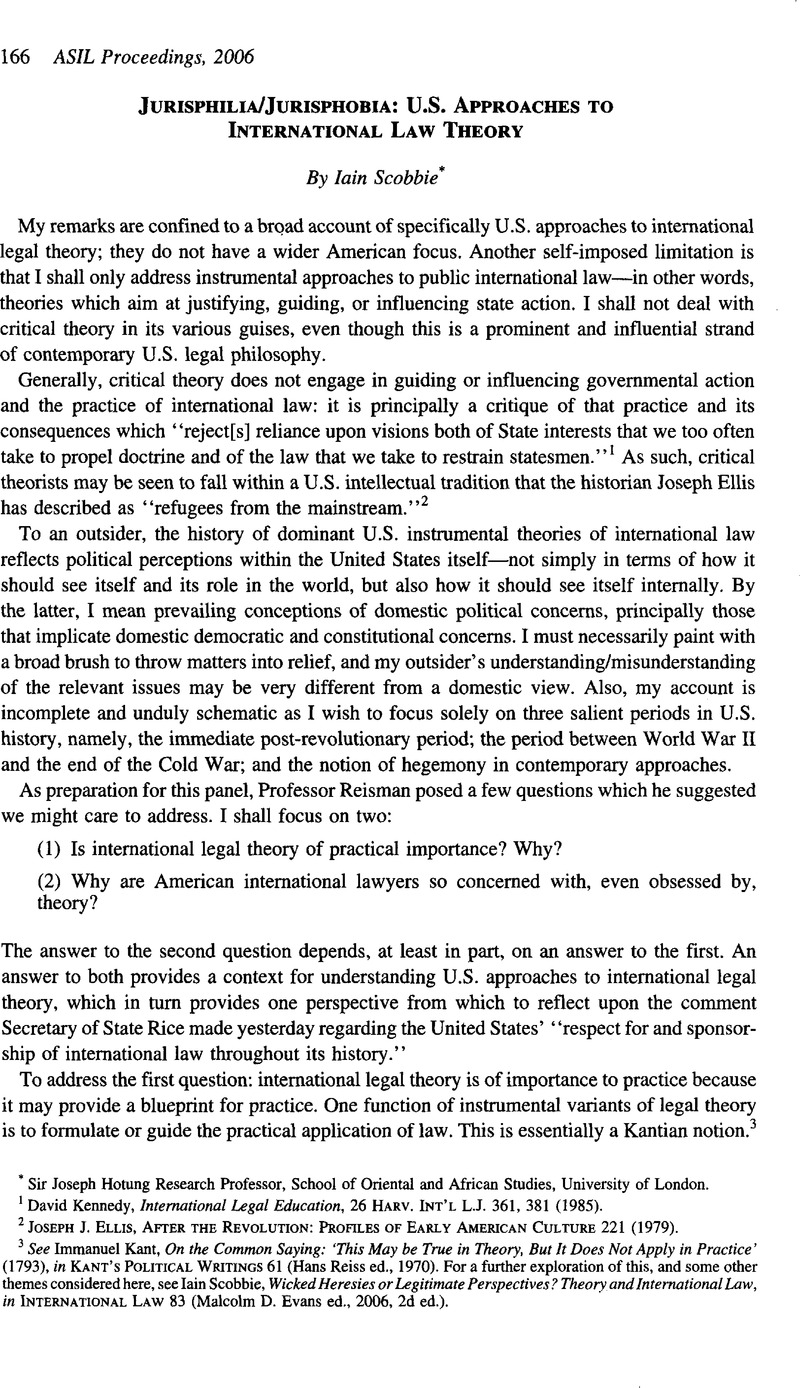No CrossRef data available.
Published online by Cambridge University Press: 28 February 2017

1 Kennedy, David, International Legal Education, 26 Harv. Int’l L. J. 361, 381 (1985)Google Scholar.
2 Joseph J. Ellis, After the Revolution: Profiles of Early American Culture 221 (1979).
3 See Kant, Immanuel, On the Common Saying: ‘This May be True in Theory, But it Does Not Apply in Practice ‘ (1793), in Kant’s Political Writings 61 (Reiss, Hans ed., 1970)Google Scholar. For a further exploration of this, and some other themes considered here, see Scobbie, Iain, Wicked Heresies or Legitimate Perspectives? Theory and International Law, in International Law 83 (Evans, Malcolm D. ed., 2006, 2d ed.)Google Scholar.
4 Quoted in Sylvester, Douglas J. International Law as Sword or Shield? Early American Foreign Policy and the Law of Nations, 32 N. Y. U. J. Int’l L. & Pol. 1, 68 (1999)Google Scholar.
5 It is admitted that eighteenth-century (and earlier) notions of the law of nations comprehended more than the notion of international law formulated by Jeremy Bentham late in that century. See, for instance, Dickinson, Edwin D. The Law of Nations as Part of the National Law of the United States, 101 U. Pa. L. Rev. 26, 26-34 (1952)CrossRefGoogle Scholar; Janis, Mark W., The American Tradition of International Law: Great Expectations 1789-1914, at 1-15 (2004)Google Scholar; Rubin, Alfred P., Ethics and Authority in International Law (1997)CrossRefGoogle Scholar.
6 Quoted in Sylvester, supra note 4, at 29. See also Walter Stahr, John Jay: Founding Father 275-76 (2005).
7 Falk, Richard, Casting the Spell: The New Haven School of International Law, 104 Yale L. J. 1991, 2001 (1995)Google Scholar.
8 Lasswell, Harold D. & McDougal, Myres S., Legal Education and Public Policy: Professional Training in the Public Interest, 52 Yale L. J. 203, 206 (1943)CrossRefGoogle Scholar.
9 Id. at 212.
10 McDougal, Myres S. & Lasswell, Harold D. The Identification and Appraisal of Diverse Systems of Public Order, in International Law Essays: A Supplement to International Law in Contemporary Perspective 15, 24 (McDougal, Myres S. & Reisman, W. Michael eds., 1981)Google Scholar. This article was first published in 53 AJIL 1 (1959).
11 See Austin, John, The Province of Jurisprudence Determined (Rumble, Wilfred A. ed., 1995) (1832)CrossRefGoogle Scholar. For Austin’s view that international law is not law but only a form of positive morality, see Lecture V, pp. 123-25. For Bolton’s adoption of Austin, see Bolton, John R. Is there Really “Law” in International Affairs?, 10 Transnat’l L. & Contemp. Probs. 1, 2, 4-5, 48 (2000)Google Scholar. Morison argues that there are affinities between Austin and the central tenets of the New Haven school. See W. L. Morison, John Austin 178-88 (1982).
12 See Jeremy A. Rabkin, Law Without Nations? Why Constitutional Government Requires Sovereign States (2005).
13 Janis, supra note 5, at 16; see generally at 16-18.
14 See, for instance, Hart’s destruction of Austin in H. L. A. Hart, The Concept of Law (2d ed. 1994); compare Morison, supra note 11.
15 For an interesting and conceptual consideration of this point, see Ralph, Jason, International Society, the International Criminal Court and American Foreign Policy, 31 Rev. Int’l Stud. 27 (2005)Google Scholar.
16 Percy Bysshe Shelley, Ozymandias (1819), lines 9-11.
17 Id., lines 12-15.